If you have experience in pro audio then the name Prism Sound may not be unfamiliar, but now the company are taking their professional credentials into the home audio marketplace. Janine Elliot takes a listen to their £1795 Callia DAC.
Prism Sound is a company I didn’t know much about, though actually I have been using some of their gear for many years. Initially a professional audio company specialising in DACs that grace many studios around the world, this company also bought (on April Fool’s day in 2008) a digital editing system called SADiE that I had been using at the BBC since the Noughties, a system both loved and hated by Studio Managers.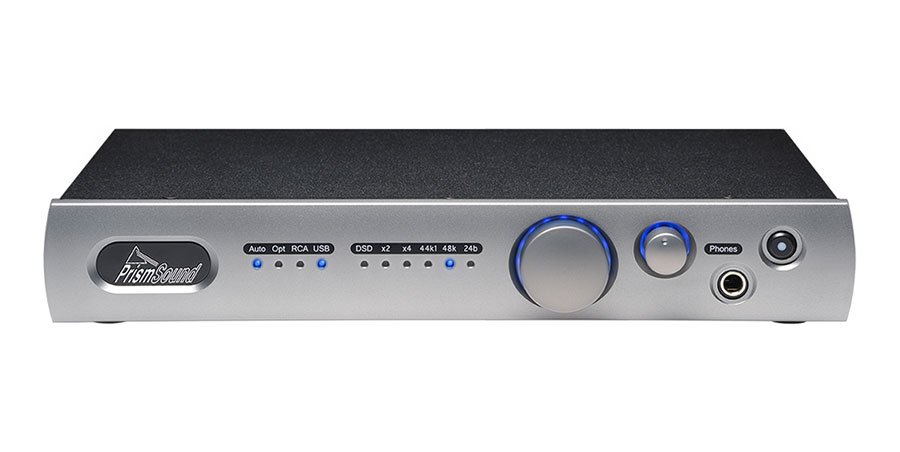
Prism Sound was set up in 1987 by two electronics engineers; Graham Boswell and Ian Dennis. The pair met in 1981 while working on digital signal processing (DSP) technology at British mixing desk manufacturer Rupert Neve & Company. Their work on DACs has not gone unnoticed, winning the Queen’s Award for International Trade in 2011 and it is good to see that they are now extending their knowledge into the domestic hifi fraternity. The Callia is their latest offering for the home, though using technology taken from their professional products. This curvy 2/3 pint-pot sized unit only lacks a remote control to get me really excited, although it does allow automatic selection of input type. Only the large and small potentiometers for line and headphone output respectively meant you occasionally needed to lean forward to turn a dial. The design goal for CALLIA was to provide excellent audio in a sophisticated but easy to use box for home use, and they certainly have succeeded in this respect, and all for a very reasonable sum of money.
The supplied instruction manual doesn’t let you know much about the product, though it gets you up and running quickly, but the unit comes complete with probably the best looking USB stick containing comprehensive manual and more importantly the drivers required for operating from your PC or Mac, plus updates. Coax and optical inputs allow up to 24bits and 192kHz plus DSD64. Whilst the USB input allows PCM up to 32bit/384kHz and DSD64 and DSD128 any sampling rates higher than 192 are reduced to levels at or below this using a high performance decimation filter. So for a 384kHz source, for example, it will be converted to 192kHz. In addition to the DSD64 (5.6448 Mbit/s) and DSD128 (11.2896 Mbit/s) bit rates, the Callia also supports the 48kHz-derived rates of 6.144 Mbit/s and 12.288 Mbit/s. The Callia uses an AMD Cortex processor for the USB side of things, and rather than today’s addiction and convenience of ESS Sabre or Texas Industries DSP chips, it uses the Cirrus Logic CS4398, though all bit different from Boswell and Dennis’s early days in digital work at Neve when everything was designed from the box up. The design is fully-balanced throughout with an excellent headphone amplifier.
Arriving in a posh cardboard box that would put any Apple presentation carton to shame, the important electronics are no less attractive; a curvy grey coloured front panel (reminding me of an Arcam of old) with enough blue LEDs to light up a Christmas tree, that either illustrate the digital credentials of your chosen source, or hold hands around the volume controls for both line out and headphones. For the line output the number of lights depends on how high you set the controls; this is a functioning work of art that makes the unit disappointing to look at when it is switched off. The power switch on the right also acts as a selector for your digital source. Sources include the usual choice of Toslink optical, S/PDif coax and USB. The first four LEDs indicate the three sources with the first LED showing whether selection is automatic. The last 6 LEDs on the front will indicate digital format and bit rate specifically showing “DSD”, “x2”, “x4”, “44.1”, “48” and “24bit”. So, for 24 bit 192kHz it would indicate “x4”,”48” and “24b”. Whilst this may look very pretty it’s a bit trying to work out the time on a binary watch. A simple 2-line display would be much easier in my opinion. Interestingly the DSD signals are internally converted to PCM before decoding to analogue (DoP; ‘DSD over PCM’). Prism Sound Chief Technology Officer Ian Dennis writes much about their choice of decoding in the Callia, and hints that most DACs will convert from DSD to PCM before decoding to analogue, something I had suspected when reviewing another DAC a while back. Certainly the design of this DAC made all inputs I tried work well, with the sound quality and design showing their background in professional audio, as well it should. That includes the four dip switches on the rear. The first switch disables the front volume control and sets the unit to a fixed output level. I personally liked this as the unit is not acting as a preamplifier. Switch 2 controls the amount of head-room when in DSD playback mode. When this switch is set to “on” the output is +3.1dB, meaning that any peaks of output won’t be clipped, though noise floor is that much less. The last two switches are for optimising the headphone impedance. Usually the line output will be muted when connecting headphones, but even that can be disabled if you wish on one of the 4 permutations of the last two dip switches. Trying both 40ohm and 300ohm headphones I found the headphone amp worked well. The unit accepts any mains voltage between 90V and 250V, so no mains voltage selection is required.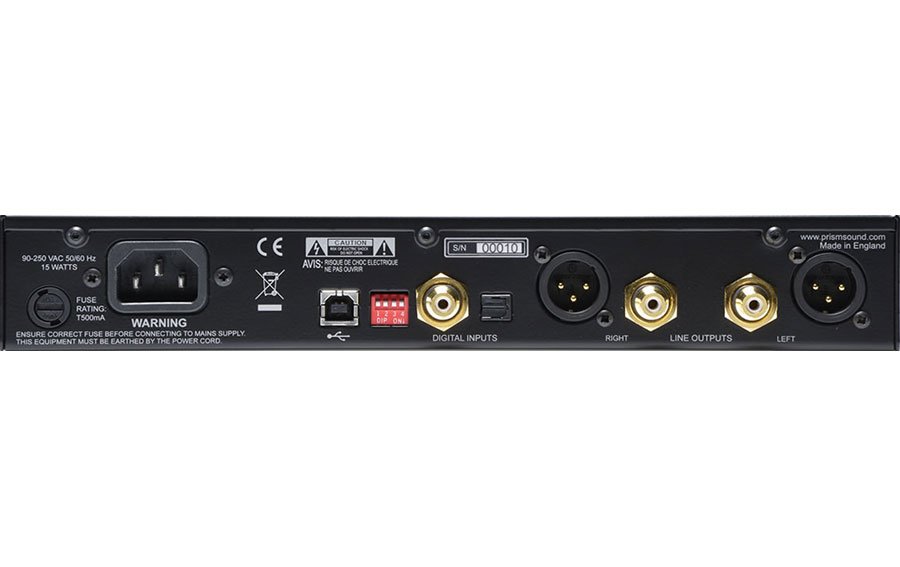
Sound
The word Callia is Greek for “very beautiful” and I hoped that all I heard would be beautiful. Indeed I was instantly drawn to the music it decoded, but I personally would have chosen a name Timios, meaning “honest”. The DAC is very honest, with plenty of attack and detail, not adding anything or taking anything from the music. I did feel, however, that the vocals were the definitive point on whether this unit was ‘beautiful’, and on a number of times I felt that midrange frequencies – particularly vocal range – seemed very slightly weak and made my own new album ‘Boxed In’ rather light in the vocal range; quite surprising me and making me sound even worse than I already think I am! Violins – within this frequency range – were extremely clear and entertaining and soundstage was captured as honestly as a professional sound engineer in a studio using Prism Sound professional gear would expect. The headphone output is surprisingly good and the balanced architecture means that the unit works well as a preamplifier in its own rights, if only it had a remote control.
Playing the Binaural Chasing the Dragon “Espana – A Tribute to Spain” album gave a sense of three-dimensionality that I hadn’t heard from other DAC/headphone amplifiers. The clarity in all frequencies and quick speed from the instruments, particularly pizzicato strings and percussion just gave a better binaural experience through my closed-back 43 ohm Audio Technica W1000 headphones than I have heard to date. Those cans have a clear and open mid and top, though some might find them slightly recessed in the bass line, though it does mean that bass is crisp and clear. The headphone section might me an add-on for the Callia, but to be honest it surpasses many headphone amplifiers I have had the pleasure of listening to over the years. As musicians turned the page at the end of each piece of music it allowed me to gain a closer relationship with all that was going on around my head. Clarity in the high frequency region was excellent. Only lowest bass seemed economical at times.
Dire Straits “Telegraph Road” from ‘Love over Gold’ is one of those tracks any prospective hifi purchaser in the latter years of the last century would have used to audition separates in Lasky’s or Comet. The track has ‘pin-sharp’ guitars and cymbals, and deep bass drum bursts that would test any woofer. The Callia’s clarity meant the infamous bad edit at 3’37” with a shift across the soundstage mid verse was even more annoying than it was when I first heard it.
Turning to the +14dBu XLR output into my balanced Krell gave for an even greater sense of clarity and power. This miniature unit was not anorexic when it came to engagement, detail and speed. This unit ensured nothing was added or taken away. The decaying long “A” on the strings linking the second half of the 14 minute movement was not an afterthought in the music. I could hear and understand why Mark Knopfler put it there, though wish I had the patience to play a single note on the violins for over 6 minutes. This sound bite was separated from the rest of the music as if I had my own 48 track studio in my living room to pre-fade each nuance individually. I could focus in on all the individual sounds, rather than just hearing a ‘mix’ like many a DAC.
Handel Organ Concertos Opus 4 (Academy of Ancient Music Richard Egarr, Harmonia Mundi 24/88.2) have many a conversation between the light flute organ melody and the heavy strings, giving an enchanting and relaxing performance, only hindered occasionally by the harmonics between some notes on the organ that resonate on an ancient organ that has perhaps seen better days. This work from around 1733 might have been aimed as interlude entertainment between acts in Handel’s popular series of oratorios, but this recording makes them centre stage as works in their own right. Whilst Egarr might have trained as a harpsichordist, his playing is beautifully poetic and detailed. The close mic’ing at St Jude’s Church in London of the English portable or ‘chamber’ organ with its four stops and characteristically sweet tone, it could be perhaps described as just a box of treble and bass recorders. Its delicacy of performance is particularly clearly heard through the Callia, though not putting me off listening. This is no Westminster Cathedral organ, and the Callia is honest enough to maintain it that way, with a speed and clarity that makes it easy to pick out tonal and mechanical errors of that organ. Only the noise of passing traffic outside the venue where it was all recorded was not as audible as I had heard in my choice headphone amplifier. Bass was perhaps not quite as generous as I would have liked, though one’s attention to the mid and high frequency detail and clarity meant that I didn’t really miss it. The accuracy and ease of production of the music was something I heard in all that I played. Much of this can be down to the lack of jitter. In order to help create that perfection in digital conversion the unit employs their CleverClox hybrid digital phase-locked loop (DPLL) clock circuitry, which I remember from their Atlas USB multi-track audio interface. Indeed, much of the circuitry is taken from their Atlas, Lyra and Titan professional products.
Conclusion
At £1,795 this is an excellent price for a combined DAC and headphone amplifier, even passing well as a preamplifier, and with balanced and coax output. A repeating observation as I reviewed this unit was of a sound that crystal clear and fast with nothing added or taken away from the music, meaning imperfections in the recordings can always be heard, which can be a bit annoying if you want just to be entertained, but ideal if you are a sound engineer. I must stress that this didn’t make the sound clinical, rather that it is detailed and accurate. Only vocals could have been a little more forthright.
If you want a slower, more relaxed and coloured sound then you need to go elsewhere, but for something that sounds this good and looks stunning as well, particularly with all the blue lights, then this may well be your best choice to decorate the music room.
Build Quality: Excellent build and good curvy looks, with attention to using good quality connectors and lots of lovely blue lights. That curvy aluminium front might look a bit “plasticky” to some
Sound Quality A very accurate and detailed sound, better than many DACs at higher price. A very able headphone amplifier, working with both low and high impedance drivers
Value For Money: At £1,795 this is a very able machine in a small package. I strongly advise you give this machine a listen
Pros:
Fast response
neutral presentation of all types of music
excellent clarity across all frequencies and using all digital formats
Open soundstage to pin-point each instrument and voice
Cons:
Could sound clinical to some, and mid-range can lack some detail
No DSD256 might upset a few
Price: £1795
Janine Elliot

















































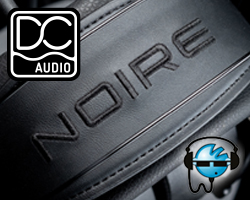

















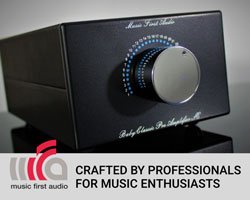


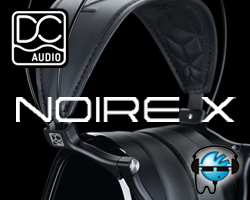






















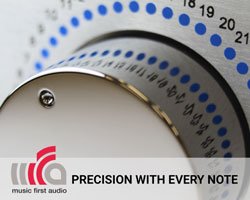
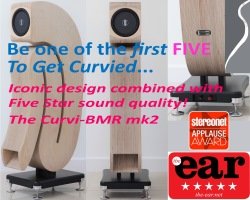













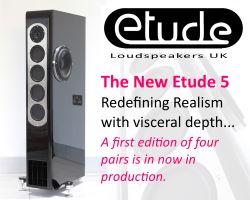





























































You must be logged in to leave a reply.